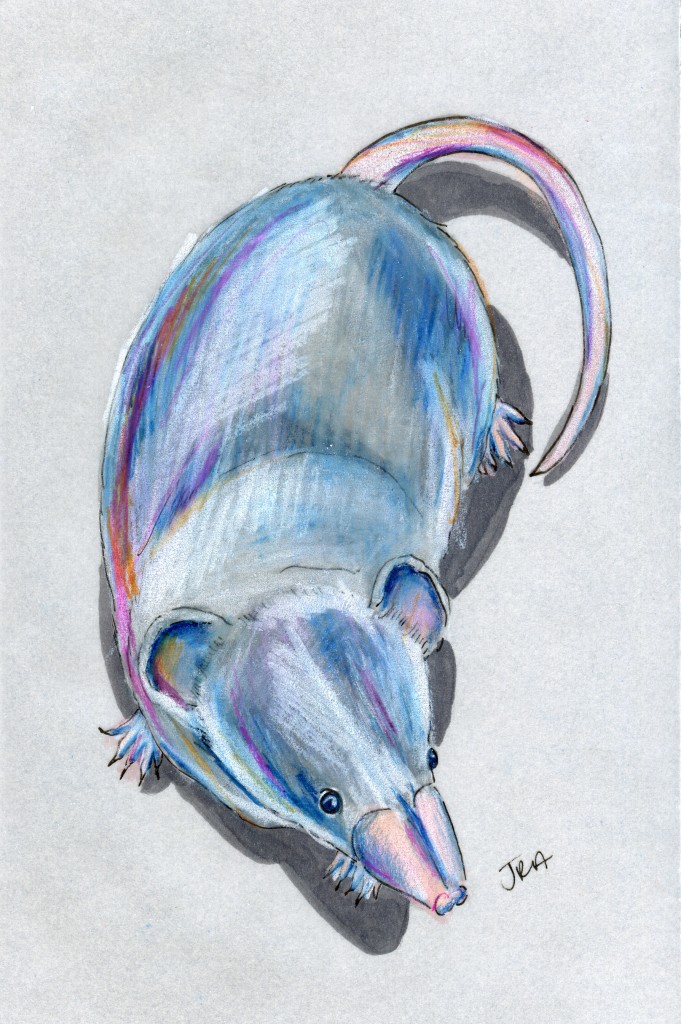Desert Shrew (Notiosorex crawfordi)
Well, haven’t I learned something today. I use Walker’s Mammals of the World, sixth edition, as a general reference for this project. It’s a huge two-volume work, the most comprehensive in existence, and invaluable to me for sorting out taxonomic questions and getting basic information about species’ habitats and habits. This edition came out in 1999, and the previous editions came out in 1991, 1983, 1975, 1968, and 1964. Looks like we’re about due for a new one, right? And good thing, too! I picked this little shrew out of my Walker’s the other day. It was listed as the only member of the genus Notiosorex. First thing I learn online is that now the consensus seems to be that there are actually four Notiosorex species, not one. Okay, that’s nothing new around here, I can deal with that.
But then I go to look at the Wikipedia pie chart of the distribution of mammalian orders, remembering—I thought—that members of the order Insectivora constituted the third-largest group. Insectivora is one of the 28 orders in Walker’s. It includes shrews, hedgehogs, and moles, shrews being in the family Soricidae. But the Wikipedia pie chart doesn’t even list insectivores. Instead, the third-largest group, behind rodents and bats, is Soricomorpha, shrew-bodies.
It turns out that taxonomically-minded people are coming to a consensus that Insectivora, which Wikipedia calls “a scrapbasket,” is in fact several separate orders—colugos in one, elephant shrews in another, hedgehogs and gymnures over there, etc., etc. Lord have mercy, but this has exploded my mammal-loving world. It’s one of the most interesting things about this project, and biology and actually, I guess, science in general, the way no one even knows how many mammals there are, people can disagree on whether this species is really the same as that species, and it’s always changing, but still, I was not expecting to lose a whole order, and one whose name I just learned to pronounce properly (stress on the third syllable).
Seventh edition of Walker’s, where are you?
This shrew, a member of Soricomorpha, lives in the southwestern United States (including my home state, New Mexico) and in Mexico. They are way smaller than you’d think: only three or four inches long on average, including their tails. They’re so small that they can actually hang out in beehives, entering and leaving through the bees’ doors.


For what it’s worth, “Soricomorpha” is now thought to be an unnatural group too as it excludes hedgehogs, which are (according to some genetic studies) more closely related to shrews than moles. “Eulipotyphla” is the handy term used these days for “true insectivores” i.e. shrews, moles, hedgehogs, solenodons, moon rats, desmans and what not.
Oh my goodness, it’s even worse than I thought! Thanks for the update, Neil. No wonder Walker’s hasn’t come out with a new edition. They should probably go with a pure online subscription model so they can keep it updated more easily. But I hope they don’t. Do you think that as genetic studies progress it will all get finally sifted out and stop changing?
I imagine EOL or such projects might eventually displace published tomes like Walker’s. This would be sort of sad, but hopefully would mean that more people would access to accurate information about animals (Walker’s is EXPENSIVE!)
As to whether we will ever reach reach an absolute phylogenetic consensus? That’s a very interesting question, but probably one that Christopher Taylor could answer much better than. I do suspect that higher level relationships among mammals will settle down a bit in the near term. In the long term of course, there’s no telling when a new discovery or development of a new technique will require a major overhaul, that’s the tragedy/beauty of science I suppose.
This supertree helps to put things in perspective.
very cool Hawaii animals and commentary